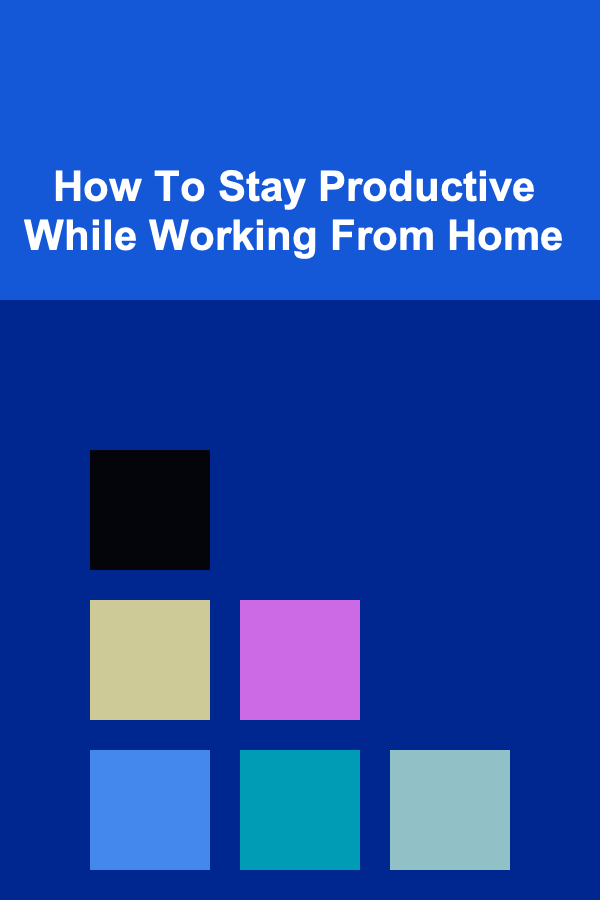
How To Stay Productive While Working From Home
ebook include PDF & Audio bundle (Micro Guide)
$12.99$10.99
Limited Time Offer! Order within the next:

The global shift towards remote work has been one of the most significant changes in the workplace over the past few years. Many individuals now have the flexibility to work from home, but this new working environment brings its own unique set of challenges. Staying productive while working from home can be difficult for some people due to distractions, lack of structure, and the blurred lines between work and personal life. However, with the right strategies, it is possible to maintain high productivity levels and even thrive in a home office setting.
This article explores practical tips, strategies, and tools that can help you stay productive while working from home, ensuring that you can stay on track, meet deadlines, and maintain a healthy work-life balance.
Establish a Designated Workspace
One of the most critical steps in staying productive while working from home is creating a dedicated workspace. The temptation to work from the couch or your bed might seem appealing, but these environments are often associated with relaxation and entertainment, not productivity.
Benefits of a Designated Workspace
- Separation of Work and Life: A designated workspace helps create a physical boundary between your work and personal life. This separation is essential for maintaining focus during work hours and unwinding after work.
- Increased Focus: When you have a specific space for work, your brain associates that environment with productivity, which can enhance focus and concentration.
- Reduced Distractions: A workspace designed specifically for work will help minimize distractions, making it easier to stay on task.
Tips for Setting Up Your Workspace
- Choose a Quiet Spot: Select an area in your home that is away from distractions like TV, loud conversations, or household chores.
- Invest in Ergonomics: Ensure your workspace is comfortable with an ergonomic chair, a desk at the right height, and a screen positioned at eye level to avoid strain.
- Keep It Organized: A clutter-free workspace can significantly improve focus and mental clarity. Keep only the essentials on your desk and store everything else out of sight.
Set a Clear Schedule
When working from home, it can be challenging to stick to a routine. Without the structure of commuting and office hours, it's easy to fall into a pattern of procrastination or overwork. A clear schedule helps bring structure to your day, keeping you on track and ensuring that you remain productive throughout the workday.
How to Create a Productive Schedule
- Set Regular Working Hours: Define the hours you will be working each day and stick to them. This consistency helps create a routine, so both your mind and body can adjust to the workday rhythm.
- Time Blocking: Allocate specific time blocks for different tasks or activities. For instance, you can dedicate the first two hours of the day to focused work, followed by a 15-minute break, then another block for meetings or collaboration.
- Use the Pomodoro Technique: The Pomodoro Technique involves working in focused intervals, typically 25 minutes of work followed by a 5-minute break. After four intervals, take a longer break. This method helps maintain focus and prevent burnout.
Tools for Managing Your Schedule
- Calendar Apps: Tools like Google Calendar or Microsoft Outlook can help you organize your work schedule and set reminders for important meetings or deadlines.
- Task Management Tools: Software like Todoist, Trello, or Asana can help you manage and prioritize tasks, set deadlines, and track progress.
Minimize Distractions
Working from home offers flexibility but also brings many potential distractions. From household chores to family members or pets, staying focused can be a challenge. To stay productive, it's important to identify and minimize distractions in your environment.
Strategies for Reducing Distractions
- Set Boundaries with Family and Housemates: Communicate your working hours to family members or roommates, ensuring they respect your workspace and minimize interruptions.
- Limit Social Media Usage: Social media is one of the biggest productivity killers. Consider using tools like Freedom or StayFocusd to block distracting websites during work hours.
- Turn Off Notifications: Disable unnecessary notifications on your phone and computer to avoid constant interruptions. You can use apps like Do Not Disturb mode to silence distractions while working.
Create a Productive Atmosphere
- Noise-Canceling Headphones: If you are working in a noisy environment, noise-canceling headphones can help block out distractions and improve focus.
- Background Music or White Noise : Some people find that playing soft background music or white noise can help them concentrate. Apps like Noisli or Brain.fm offer customizable soundscapes to enhance productivity.
Set Clear Goals and Prioritize Tasks
Clear goals are essential for staying productive, as they give you a sense of purpose and direction throughout the day. Without clear objectives, it's easy to get sidetracked or lose motivation.
How to Set Effective Goals
- Use SMART Goals: Set goals that are Specific, Measurable, Achievable, Relevant, and Time-bound. This framework ensures that your goals are clear and actionable.
- Break Down Large Tasks: Large tasks can feel overwhelming. Break them down into smaller, more manageable steps to make progress feel more achievable.
- Prioritize Your Tasks: Use methods like the Eisenhower Matrix or the ABC prioritization method to focus on the most important tasks first. These frameworks help you distinguish between urgent, important, and non-essential tasks.
Goal-Setting Tools
- Notion: Notion is an all-in-one workspace where you can create tasks, track goals, and organize your work. It's highly customizable and can be used to create detailed to-do lists, project boards, and calendars.
- Todoist: A task management app that helps you organize your day by listing tasks, setting deadlines, and assigning priorities.
Take Regular Breaks
Taking breaks might seem counterintuitive when trying to stay productive, but breaks are actually essential for maintaining long-term focus and energy levels. Continuous work without breaks can lead to burnout and decreased productivity.
Why Breaks Matter
- Improved Focus: Breaks allow your brain to rest and recharge, helping you return to work with improved focus and creativity.
- Reduced Stress: Stepping away from your desk for a few minutes can help alleviate stress and prevent mental fatigue.
- Increased Productivity: Taking regular breaks has been shown to boost overall productivity and prevent the negative effects of prolonged sitting or working.
Best Practices for Taking Breaks
- Schedule Breaks: Incorporate breaks into your schedule. For example, follow the Pomodoro Technique and take a 5-minute break after 25 minutes of focused work.
- Take Active Breaks: Use breaks to stretch, walk around, or do light exercises to refresh your body and mind. Sitting for long periods can lead to physical discomfort and reduced focus.
Use Technology to Stay Organized
Technology offers a wide range of tools that can help you stay organized, collaborate with colleagues, and manage tasks effectively. Leveraging the right technology can significantly improve your productivity and efficiency when working from home.
Essential Tools for Remote Work
- Project Management Software : Tools like Trello, Asana, or Monday.com can help you organize your projects, track progress, and collaborate with team members.
- Communication Platforms: Tools like Slack, Microsoft Teams, or Zoom are essential for virtual communication with colleagues and clients. These tools help maintain collaboration and ensure you're always connected.
- Cloud Storage: Use cloud storage solutions like Google Drive, Dropbox, or OneDrive to access and share documents easily from anywhere. Cloud storage ensures that your work is safe and accessible across devices.
Time Management Apps
- RescueTime: This app tracks how you spend your time on your computer and provides insights into your productivity. It helps identify time-wasting habits and improves focus.
- Toggl: Toggl is a time-tracking tool that allows you to monitor how much time you spend on different tasks, helping you manage your time more effectively.
Stay Connected and Maintain a Routine
Remote work can sometimes feel isolating, especially if you're used to working in an office with a team. Maintaining connections with colleagues, having regular check-ins, and participating in virtual team activities can help keep your morale high and ensure that you remain engaged with your work.
How to Stay Connected
- Schedule Regular Check-Ins: Set up regular meetings with your team to discuss ongoing projects, share updates, and stay aligned on goals. This can be done through video calls, phone calls, or messaging platforms.
- Join Virtual Events: Participate in online events, webinars, or virtual social hours to stay connected with your colleagues and network.
- Maintain a Work-Life Balance: It's important to create boundaries between work and personal life. Set clear start and end times for your workday and make time for activities that help you unwind and relax.
Focus on Mental and Physical Well-Being
While staying productive is important, it's equally essential to take care of your mental and physical health. Working from home can blur the lines between work and personal time, making it easy to overwork and neglect self-care.
Tips for Mental and Physical Well-Being
- Exercise Regularly: Incorporate physical activity into your daily routine. Exercise boosts energy levels, reduces stress, and improves focus.
- Practice Mindfulness: Mindfulness practices like meditation or deep breathing can help reduce stress and enhance focus. Apps like Headspace or Calm offer guided meditation sessions.
- Get Enough Sleep: Adequate sleep is crucial for mental clarity and productivity. Ensure you get 7-9 hours of sleep each night to stay alert and focused throughout the day.
Conclusion
Staying productive while working from home requires discipline, structure, and the right mindset. By creating a designated workspace, sticking to a clear schedule, minimizing distractions, and using the right tools, you can stay focused and efficient. Remember that taking care of your mental and physical well-being is just as important as staying productive, and maintaining a healthy work-life balance will ultimately help you achieve greater success and fulfillment in your remote work journey.

How to Find Local Resources for Financial Assistance
Read More
How to Set Up a Home Gym with Smart Storage Solutions
Read More
How to Use Color to Create a Warm and Inviting Home Staging Look
Read More
How To Make Delicious Espresso Without an Expensive Machine
Read More
How to Get Cheap Accommodation in Major Cities
Read More
How To Create Engaging Art Projects for Young Children
Read MoreOther Products

How to Find Local Resources for Financial Assistance
Read More
How to Set Up a Home Gym with Smart Storage Solutions
Read More
How to Use Color to Create a Warm and Inviting Home Staging Look
Read More
How To Make Delicious Espresso Without an Expensive Machine
Read More
How to Get Cheap Accommodation in Major Cities
Read More